INDIFFERENCE CURVES: PRICE EFFECT
MICROECONOMICS

|
PRICE EFFECT |

|
Introduction |
In the previous section we have seen how optimal consumption combination, the one that maximizes the utility of spendable income, is determined at the point where budget constraint is tangent to an indifference curve. In other words, the combination at which marginal rate of substitution equals the price ratio, as explained in User:Sanghamitra. However, economic conditions are constantly changing. Some times there is change in the price of a good or there is change in the consumer's income. The consumer then rearranges her/his consumption combination in order to maximize utility of her/his spendable income.
| Price Effect |
In this section we are going to study price effect. In other words, understand how the optimal consumption combination changes as a result of change in the price of good X (PX), Price of Good Y (PY) and Consumer's income remaining unchanged.
A price effect represents change in consumer’s optimal consumption combination on account of change in the price of a good and thereby changes in its quantity purchased, price of another good and consumer’s income remaining unchanged. The consumer is better-off when optimal consumption combination is located on a higher indifference curve and vice versa.
Understand that a consumer's responses to a price change differ depending upon the nature of the good, viz. a normal good, inferior good or a neutral good. These are summarized in chart.1:
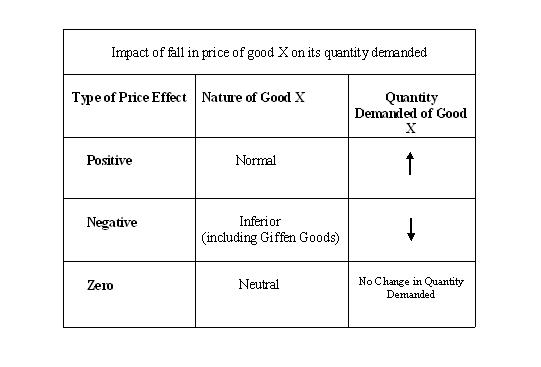
Thus, a price effect is positive in case of normal goods. There is inverse relationship between price and quantity demanded. It is negative in case of inferior goods (including Giffen goods) where we find direct relationship between price and quantity demanded. Finally, price effect is zero in case of neutral goods where consumer's quantity demanded is fixed.
Solve the following activity. We then move on to understand positive, negative and zero price effects with the help of indifference curves.
| Positive Price Effect |
In this section we are going to study how the optimal consumption combination changes as a result of change in the price of good X (PX) which is a normal good. Price of Good Y (PY) and consumer's income remaining unchanged. Figure.1 starts with the initial optimal consumption combination attained at point e as discussed in User:Sanghamitra
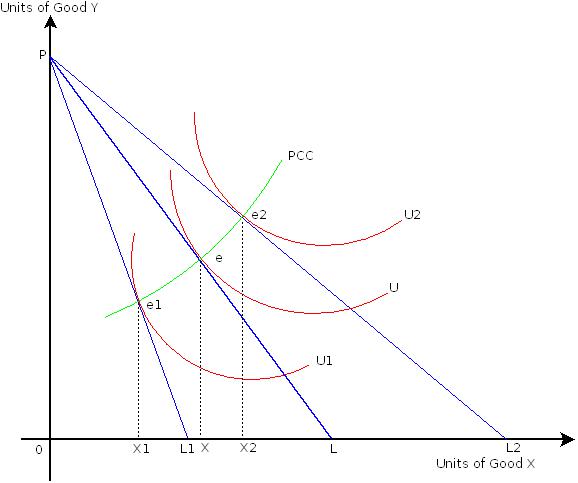
Whenever price of a good representing X-axis change, lower point of the budget constraint shifts as shown in Figure.1.
When the price of good X increases, the budget constraint then becomes steeper, as the lower end point moves leftward. This is shown by budget constraint PL1. The optimal consumption is located at point e1 at which the consumer buys OX1 units of good X. Consumer’s total utility decreases as the optimal consumption combination is located on a lower indifference curve U1.
Similarly, when the price of good X decreases, the budget constraint becomes flatter, as the lower end point moves rightward. This is shown by budget constraint PL2. The optimal consumption is now located at point e2, at which the consumer buys OX2 units of good X. Consumer’s total utility increases as the optimal consumption combination is now located on a higher indifference curve U2.
Chart.2 presents a summary of Figure.1.
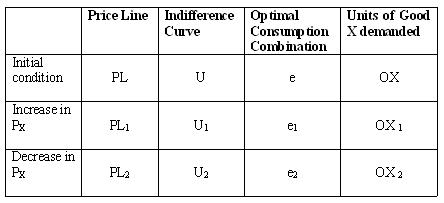
The curve obtained by joining optimal consumption combinations such as e1, e and e2 is called the price consumption curve (PCC). The PCC in Figure.1 is rising upwards to the right. It shows that the consumer successively moves on a higher indifference curve and becomes better off, with a fall in the price of good X (PX).
| Negative Price Effect |
We now study negative price effect. Good X is an inferior good. You will now understand how consumer's optimal consumption combination changes as a result of change in the price of good X (PX) which is an inferior good. Price of good Y (PY) and consumer's income remaining unchanged. Figure.2 starts with the initial optimal consumption combination attained at point e at which OX units of good X are purchased.
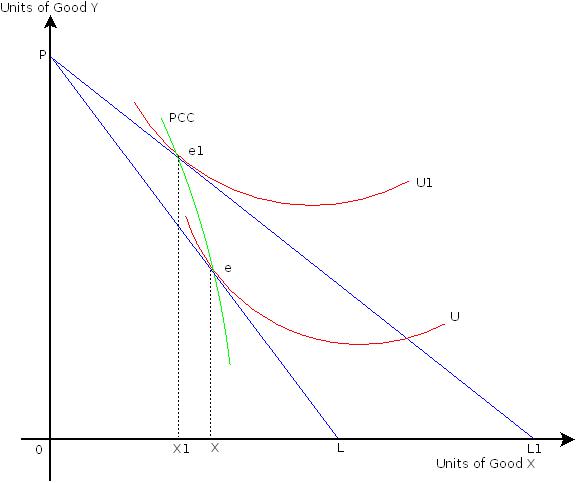
When the price of good X decreases, the budget constraint becomes flatter, as the lower end point moves rightward. This is shown by budget constraint PL1. The optimal consumption is now located at point e1, at which the consumer now buys OX1 units of good X.
Understand that consumer’s total utility has increased as the optimal consumption point is now located on a higher indifference curve U1. The consumer is better-off in terms of total utility. However, she/he reduces consumption of good X to OX1 units as good X is inferior. As mentioned in chart.1 we observe direct relationship between price and quantity demanded of good X.
Chart.3 presents a summary of Figure.2.
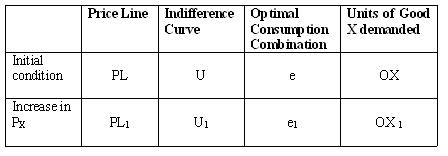
The pcc obtained by joining optimal consumption combinations such as e, and e1, in Figure.2 rises upwards but bending backwards. It shows that the consumer successively moves on a higher indifference curve and becomes better off, with a fall in the price of good X (PX). She/he is also reducing purchase of good X as it is an inferior good.
| Zero Price Effect |
We now study zero price effect. Good X is a neutral good. You can now see how consumer's optimal consumption combination changes as a result of change in the price of good X (PX) which is a neutral good. Price of good Y (PY) and consumer's income remaining unchanged. Figure.3 starts with the initial optimal consumption combination attained at point e at which OX units of good X are purchased.
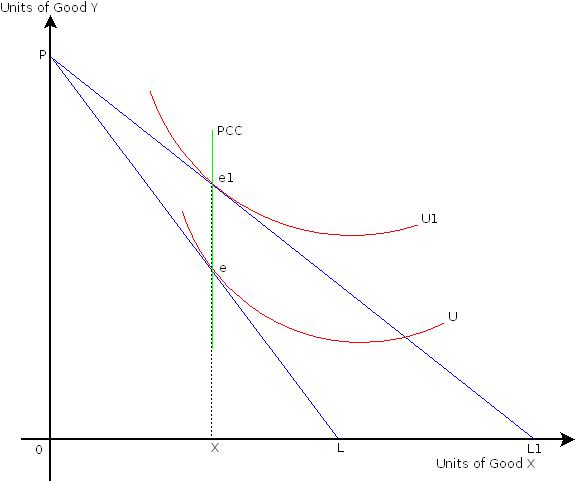
When the price of good X decreases, the budget constraint becomes flatter, as the lower end point moves rightward. This is shown by budget constraint PL1. The optimal consumption is located at point e1, at which the consumer now buys same OX units of good X.
Understand that consumer’s total utility has increased as the optimal consumption point is now located on a higher indifference curve U1. The consumer is better-off in terms of total utility. However, she/he keeps consumption of good X to same OX units as good X is a neutral good. As mentioned in chart.1 we observe no change in quantity demanded of good X.
Chart.4 presents a summary of Figure.3.
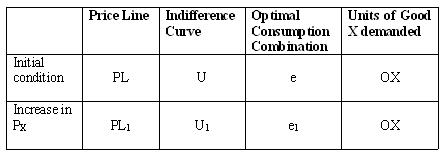
The pcc obtained by joining optimal consumption combinations such as e, and e1, in Figure.3 is a vertical straight line. It shows that the consumer successively moves on a higher indifference curve and becomes better off, with a fall in the price of good X (PX). She/he is keeping purchase of good X fixed as it is a neutral good.
| Forms of Price Consumption Curve |
In the above discussion on positive, negative and zero price effects we have considered good X to be normal good, inferior good and neutral good respectively. Similarly, we can explain price effect for different types of good Y. Figure.4 shows different forms of PCC for different natures of good X or good Y.
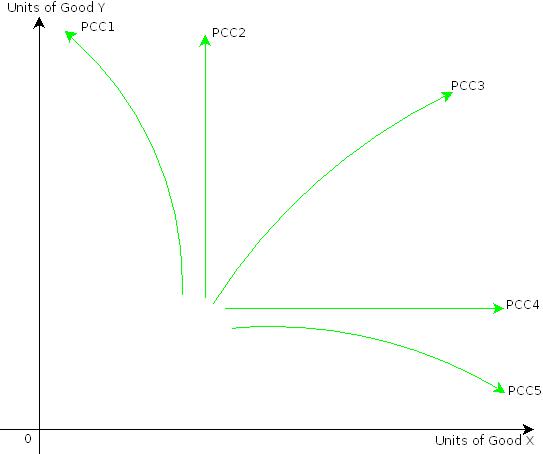
PCC1 is rising upwards and bending towards Y-axis. This form of PCC is obtained when good X is an inferior good (including Giffen goods). The PCC is a vertical straight line as shown by PCC2 when good X is a neutral good. It is a rising curve from left to right as shown by PCC3 when either good X or good Y is a normal good.The PCC is a horizontal straight line as shown by PCC4 when good Y is a neutral good. Finally, PCC5 is rising upwards bending towards X-axis. This form of PCC is obtained when good Y is an inferior good (including Giffen goods). Chart.5 presents a summary of Figure.4.
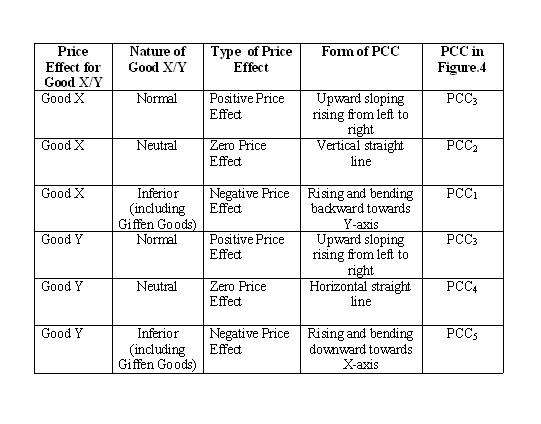

|
Activity |
| Do you want to see some cartoons on price effect?
http://vle.south.du.ac.in//mod/quiz/view.php?id=5933 Prices of almost all food items in India had soared around June-September 2011. This had affected consumption of basic food items of the people. The cartoon is based on that. [1]
| |

|
Activity |
| Write your activity here | |
| Example: {{{Example}}} |
|

|
Self-Assessment Questions (SAQs) {{{n}}} |
| {{{SAQ}}} | |

|
Results |
People respond to changes in relative prices in order to maximize the utility of spendable income. The price effect represents changes in optimal consumption combination on account of changes in relative prices.
In term of indifference curves, a consumer is better-off when optimal consumption combination is located on a higher indifference curve and vice versa, as a result of relative price changes.
Consumer’s responses to relative price changes vary depending upon the nature of goods. It is positive, negative and zero for normal good, inferior good and neutral good respectively.
These varying responses are important determinants of different forms of market demand curves.

|
Key Terms |

|
Further Readings |
|
|
Global Hunger Index 2011 - The Challenge of Hunger: Taming Price Spikes and Excessive Food Price Volatility
Report
—
Concern Worldwide, Deutsche Welthungerhilfe e. V. (German Agro Action), International Food Policy Research Institute
2011 Global Hunger Index
Fact and Findings: Asia
South Asia has the highest regional 2011 Global Hunger Index (GHI) score—22.6. The 2011 GHI score fell by 25 percent in South Asia compared with its 1990 score, and the 2011 GHI score in Southeast Asia decreased by 44 percent.
The South Asia region reduced its GHI score by more than 6 points between 1990 and 1996—mainly due to a large decline in underweight in children under five, but the fast progress was not maintained. South
Asia has lowered its GHI score by only one point since 2001 despite strong economic growth. Social inequality and the low nutritional, educational, and social status of women, which is a major cause of child under nutrition in the region, have impeded improvements in the GHI score.
Bangladesh and Vietnam saw large gains in improving their GHI score between the 1990 GHI and the 2011 GHI. Vietnam reduced its score by 56 percent, and Bangladesh reduced its score by 36 percent.
In Bangladesh—a country where 25 percent of the population is ultra-poor (living on less than USD $0.50 a day)—only about 7 percent of the population has access to social protection or safety net programs.
The GHI score for North Korea increased by 18 percent since 1990. A weak economy, high military spending, weather-related crop failures, and systematic problems in the agricultural sector have hampered progress.
Cambodia is the only country to improve from an “extremely larming” to “serious” level of hunger since 1990.
Bangladesh, India, and Timor-Leste have the highest prevalence—more than 40 percent—of underweight in children under five.
India ranks below China, Pakistan in Global Hunger Index 2011
ET Bureau Oct 12, 2011, 04.13am IST
Tags:
NEW DELHI: India ranked way below its South Asian neighbours Pakistan, Sri Lanka and China in the global hunger index 2011 released by the International Food Policy and Research Institute. South Asia fared worse than Sub-Saharan Africa netting a score of 22.6 on the global hunger index, or GHI, the report said.
While, India stood 67th amongst 81 countries, Pakistan ranked 59, China ranked fourth, Vietnam ranked 25 and Sri Lanka ranked 36 in the GHI. The report blamed high volatility in food prices for rising hunger levels worldwide.
"The poorest and most vulnerable people bear the heaviest burden when food prices spike or swing unpredictably," said Klaus von Grebmer, lead author of the report and IFPRI Communications Director in the press release.
|- | XXX.5
|
|
- People respond to changes in relative prices in order to maximize the utility of spendable income. The price effect represents changes in optimal consumption combination on account of changes in relative prices.
- In term of indifference curves, a consumer is better-off when optimal consumption combination is located on a higher indifference curve and vice versa, as a result of relative price changes.
- Consumer’s responses to relative price changes vary depending upon the nature of goods. It is positive, negative and zero for normal good, inferior good and neutral good respectively.
- These varying responses are important determinants of different forms of market demand curves.
|- | XXX.6
|
|
Marginal Rate of Substitution: It is the rate at which the consumer is willing to substitute one good for another in consumption.
Price Effect: It represents change in consumer’s optimal consumption combination on account of change in the price of a good and thereby changes in its quantity purchased, price of another good and consumer’s income remaining unchanged.
Positive Price Effect is obtained in case of normal goods. In this case changes in quantity demanded of a good, as a result of price effect, are inversely related to the price change.
Negative Price Effect is obtained in case of inferior goods (including Giffen goods). In this case changes in quantity demanded of a good, as a result of price effect, are directly related to the price change.
Zero Price Effect is obtained in case of neutral goods. In this case there are no changes in quantity demanded of a good as a result of price effect.
|}
Microeconomics, Macroeconomics and Economic Policy
| Essays in Honour of Malcolm Sawyer
Palgrave Macmillan, September 2011ISBN: 978-0-230-29019-8, ISBN10: 0-230-29019-1, 6 1/8 x 9 1/4 inches, 280 pages, 8 b/w tables, 15 figures, |
4 Schaum's Outline of Microeconomics, Fourth Edition (Schaum's Outline Series) [Paperback]
Dominick Salvatore [[Image:]]
Dominick Salvatore (Author)
› Visit Amazon's Dominick Salvatore Page
Find all the books, read about the author, and more.
See search results for this author
Are you an author? Learn about Author Central
(Author)
3.AP Microeconomics Crash Course (Advanced Placement (AP) Crash Course) [Paperback]
David Mayer (Author)
|


